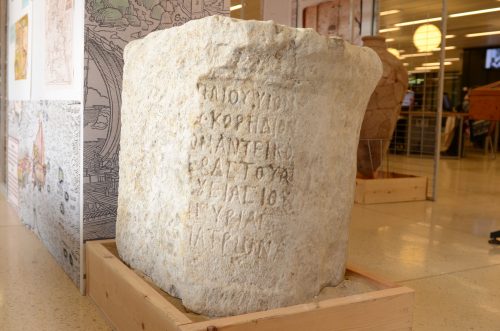This is only the second time that the name Yehuda is mentioned in any inscription from the Roman period", Prof. Assaf Yassur Landau and Dr. Gil Gambash from the University of Haifa noted*

An important underwater discovery: a rare inscription from the years before the Bar Kochba revolt identifies for the first time with certainty the Roman commissioner who ruled Judea at the time: Gergilius Antiquus. The inscription was found in the underwater excavation of the University of Haifa in and around Tel Dor. "Not only are we able to identify with certainty for the first time the name of the commissioner who ruled Judea in the critical years before the Bar-Kochva rebellion, but this is only the second time that the name Yehuda is mentioned in any inscription from the Roman period," noted Prof. Assaf Yassur Landau, who is managing the underwater excavation and Dr. Gil Gambash, who collaborated with him to decipher the inscription.
Tel Dor, which is associated with the biblical generation and operated at least until the fourth century AD, has been excavated since the first half of the 20th century, with Dr. Ayelet Gilboa from the University of Haifa and Prof. Ilan Sharon from the Hebrew University leading the excavation since 2003, joined by Prof. Rivka Martin from the University Boston and Prof. Yassor Landau from the University of Haifa, who is also responsible for the underwater survey around Dor.
Anchors, pottery and many other artifacts have already been found in the bays of Dor, but it seems that nothing prepared the researchers for the latest find. During the month of January, in the territory of the Tel Dor Reserve, the research students from the Coastal Archeology Laboratory of the University of Haifa, Ehud Arkin-Shelo and Michelle Kreischer, found a huge rectangular stone, when already under water it was possible to notice that an inscription had been engraved on it. In consultation with Kobi Sharvit, head of the maritime area at the Antiquities Authority, and Vigal Ben Ari, head of the coastal area at the Nature and Parks Authority, it was decided to remove the inscription from the sea as quickly as possible to prevent damage to the inscription or its covering with sand.
After a complicated engineering operation to remove the stone, the researchers discovered that they were looking at a carved rectangular stone with a height of 85 centimeters and a weight of over 600 kg. A seven-line Greek inscription was engraved on top of the stone. "Apparently, it is the base of a statue from the Roman period and, as far as we know, it is the longest inscription discovered underwater in Israel," said Prof. Yassur-Landau.
Dr. Gambash, head of the Department of Maritime Civilizations at the University of Haifa, joined the decoding work. The deciphering work on the worn stone is not yet finished, but the researchers have already found two exciting discoveries. The first and central one, the inscription states the name of Gergilius Antiquus and his position: governor of Judea (Judea). The name of Antiquus was already found in a similar inscription about 70 years ago, but at that time the part of the inscription indicating in which province was not preserved. In the scientific debate, there were those who believed that the inscription indicated his position as commissioner of the Syrian province, but there were those who believed that the inscription indicated the fact that he was the commissioner of Judah. Now, the new inscription proves beyond any doubt: Gergilius Antiquus is the Roman proconsul of Judah in the years before the outbreak of the Bar-Kochba rebellion in 131 AD.
But it is not only the title of Antiquus that is so rare. In fact, the name Judah is found to this day in one more Roman inscription: in the famous inscription from Caesarea that mentions the procurator Pontius Pilate. Now the number of Roman inscriptions in which Judah appears is doubled. "Immediately after the suppression of the Bar Kochba rebellion, Rome decides to abolish the province of Judah, and to erase any memory of its name, therefore it decides to annex Syria to create one province: 'Syria Palestine'. So we see an inscription that dates to a very short time before Judah actually ceased to exist as a province of that name. Of the two inscriptions that mention the name Yehuda, it is of course the later one, but in light of their rarity - it is likely that they will not find many inscriptions with the name Yehuda that are later," the researchers point out.
With the completion of the complete decipherment, the researchers will be free to examine the historical context of the inscription. "Along with the inscription found around the establishment of the state, we have two statues that honor Commissioner Antiquus and glorify his name. The question is why? "Is it a celebration of two different major events or was it acceptable to erect a new statue for the city's patron for no particular reason," the researchers will check.
The inscription will be revealed to the public for the first time at the Yunus and Soraya Nazarian Library at the University of Haifa, in a special exhibition entitled 'Via Maris'. The exhibition will officially open on 30.11.2016 during the fourth Haifa conference for the study of the Mediterranean Sea, whose theme this year is Mediterranean history. The exhibition and the conference were organized by Dr. Gil Gambash and Dr. Zur Shalu (History), in preparation for the opening of the Center for the Study of the History of the Mediterranean Sea at the University of Haifa.
